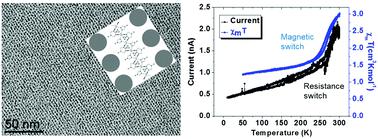Our official English website, www.x-mol.net, welcomes your feedback! (Note: you will need to create a separate account there.)
Spin crossover in Fe(triazole)–Pt nanoparticle self-assembly structured at the sub-5 nm scale
Nanoscale ( IF 6.7 ) Pub Date : 2020-04-03 , DOI: 10.1039/d0nr02154g Suhail Usmani 1, 2, 3, 4, 5 , Mirko Mikolasek 3, 4, 5, 6, 7 , Angélique Gillet 1, 2, 3, 4, 5 , José Sanchez Costa 3, 4, 5, 6, 7 , Mathilde Rigoulet 1, 2, 3, 4, 5 , Bruno Chaudret 1, 2, 3, 4, 5 , Azzedine Bousseksou 3, 4, 5, 6, 7 , Benedikt Lassalle-Kaiser 7, 8, 9, 10 , Phillipe Demont 3, 4, 5, 11, 12 , Gábor Molnár 3, 4, 5, 6, 7 , Lionel Salmon 3, 4, 5, 6, 7 , Julian Carrey 1, 2, 3, 4, 5 , Simon Tricard 1, 2, 3, 4, 5
Nanoscale ( IF 6.7 ) Pub Date : 2020-04-03 , DOI: 10.1039/d0nr02154g Suhail Usmani 1, 2, 3, 4, 5 , Mirko Mikolasek 3, 4, 5, 6, 7 , Angélique Gillet 1, 2, 3, 4, 5 , José Sanchez Costa 3, 4, 5, 6, 7 , Mathilde Rigoulet 1, 2, 3, 4, 5 , Bruno Chaudret 1, 2, 3, 4, 5 , Azzedine Bousseksou 3, 4, 5, 6, 7 , Benedikt Lassalle-Kaiser 7, 8, 9, 10 , Phillipe Demont 3, 4, 5, 11, 12 , Gábor Molnár 3, 4, 5, 6, 7 , Lionel Salmon 3, 4, 5, 6, 7 , Julian Carrey 1, 2, 3, 4, 5 , Simon Tricard 1, 2, 3, 4, 5
Affiliation

|
A main goal of molecular electronics is to relate the performance of devices to the structure and electronic state of molecules. Among the variety of possibilities that organic, organometallic and coordination chemistries offer to tune the energy levels of molecular components, spin crossover phenomenon is a perfect candidate for elaboration of molecular switches. The reorganization of the electronic state population of the molecules associated to the spin crossover can indeed lead to a significant change in conductivity. However, molecular spin crossover is very sensitive to the environment and can disappear once the molecules are integrated into devices. Here, we show that the association of ultra-small 1.2 nm platinum nanoparticles with FeII triazole-based spin crossover coordination polymers leads to self-assemblies, extremely well organized at the sub-3 nm scale. The quasi-perfect alignment of nanoparticles observed by transmission electron microscopy, in addition to specific signature in infrared spectroscopy, demonstrates the coordination of the long-chain molecules with the nanoparticles. Spin crossover is confirmed in such assemblies by X-ray absorption spectroscopic measurements and shows unambiguous characteristics both in magnetic and charge transport measurements. Coordinating polymers are therefore ideal candidates for the elaboration of robust, well-organized, hybrid self-assemblies with metallic nanoparticles, while maintaining sensitive functional properties, such as spin crossover.
中文翻译:

Fe(三唑)-Pt纳米颗粒自组装结构的亚5nm以下自旋交叉
分子电子学的主要目标是将设备的性能与分子的结构和电子状态联系起来。在有机,有机金属和配位化学提供的多种可能性中,可以调节分子组分的能级,自旋交叉现象是阐述分子开关的理想选择。与自旋交叉相关的分子的电子态种群的重组确实可以导致电导率的显着变化。但是,分子自旋交叉对环境非常敏感,一旦将分子集成到设备中,分子自旋交叉就会消失。在这里,我们显示了超小1.2 nm铂纳米颗粒与Fe II的缔合基于三唑的自旋交联配位聚合物可导致自组装,在3 nm以下的尺度下组织非常良好。通过透射电子显微镜观察到的纳米粒子的准完全对准,除了红外光谱中的特定特征外,还证明了长链分子与纳米粒子的配合。通过X射线吸收光谱测量在这种组件中确认了自旋交叉,并且在磁性和电荷传输测量中均显示出明确的特性。因此,配位聚合物是精心设计的坚固,组织良好的杂化自组装体与金属纳米颗粒的理想候选者,同时还能保持敏感的功能特性(如旋转交联)。
更新日期:2020-04-24
中文翻译:

Fe(三唑)-Pt纳米颗粒自组装结构的亚5nm以下自旋交叉
分子电子学的主要目标是将设备的性能与分子的结构和电子状态联系起来。在有机,有机金属和配位化学提供的多种可能性中,可以调节分子组分的能级,自旋交叉现象是阐述分子开关的理想选择。与自旋交叉相关的分子的电子态种群的重组确实可以导致电导率的显着变化。但是,分子自旋交叉对环境非常敏感,一旦将分子集成到设备中,分子自旋交叉就会消失。在这里,我们显示了超小1.2 nm铂纳米颗粒与Fe II的缔合基于三唑的自旋交联配位聚合物可导致自组装,在3 nm以下的尺度下组织非常良好。通过透射电子显微镜观察到的纳米粒子的准完全对准,除了红外光谱中的特定特征外,还证明了长链分子与纳米粒子的配合。通过X射线吸收光谱测量在这种组件中确认了自旋交叉,并且在磁性和电荷传输测量中均显示出明确的特性。因此,配位聚合物是精心设计的坚固,组织良好的杂化自组装体与金属纳米颗粒的理想候选者,同时还能保持敏感的功能特性(如旋转交联)。



























 京公网安备 11010802027423号
京公网安备 11010802027423号